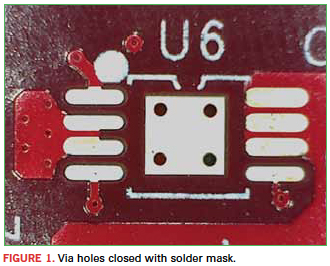No matter the size, they should always be closed.
Via-in-pad is an old issue that still pops up far too often. Our standard answer hasn’t changed: no open vias in pads. But one of the questions we get related to the subject is: What if we make the vias really small?
Logically, that makes sense. In fact, in some cases, the via is so small that it’s essentially closed. If it’s so small that it really is closed, then it’s not an open via. But look close: If it’s closed with solder, that solder may melt during reflow, leading to an open via. Small vias on HASL finished boards (leaded or lead-free) often look closed, but will melt through in the reflow oven.
The images here show some pretty small vias. I believe they’re 0.3mm in diameter. In Figure 1, it appears that the vias are open. They aren’t though. This board (an unstuffed Beagleboard) uses solder mask on the back side of the PCB to close off the vias.

Our recommended method is to plug the via with copper or epoxy and have it plated over by the fabricator. Next, we’d recommend via caps on the component side. Finally, the back side could be capped with solder mask, as is done in Figure 2, but it comes with the risk of voids. The via caps can pop open, leading to an open via.

With BGA pads, there really are only two options: Don’t put the via in the pad, or have the via plugged and plated over with metal. You can’t have any amount of open via or solder mask in a BGA land pad.
Duane Benson is marketing manager at Screaming Circuits (screamingcircuits.com); This email address is being protected from spambots. You need JavaScript enabled to view it..














